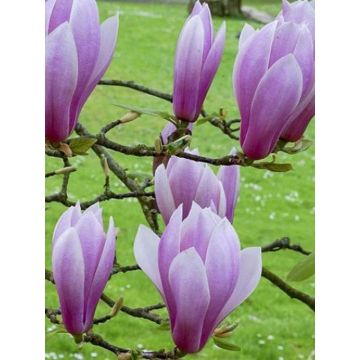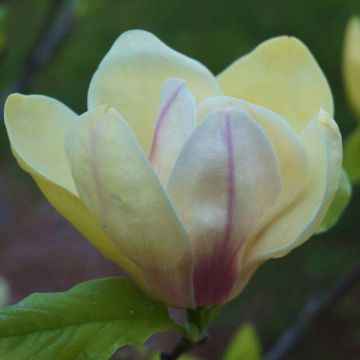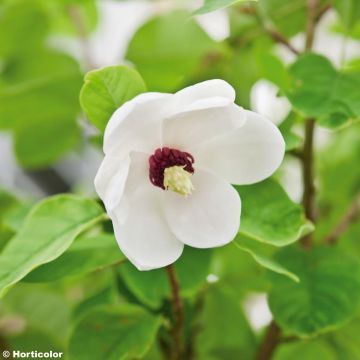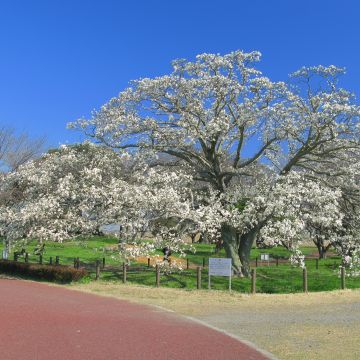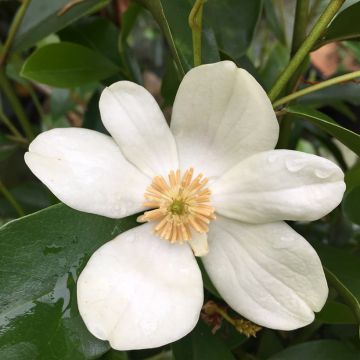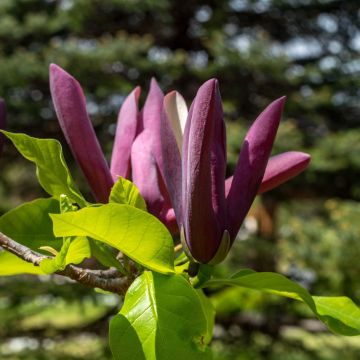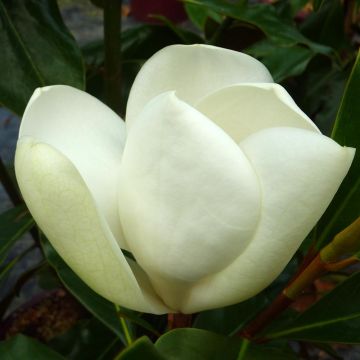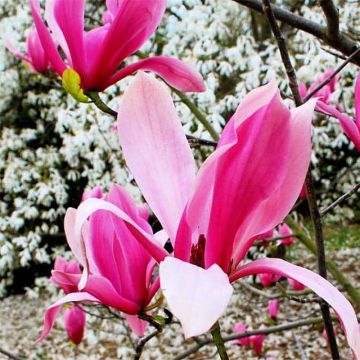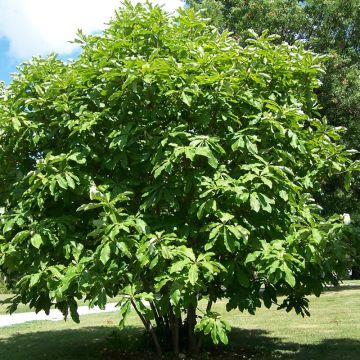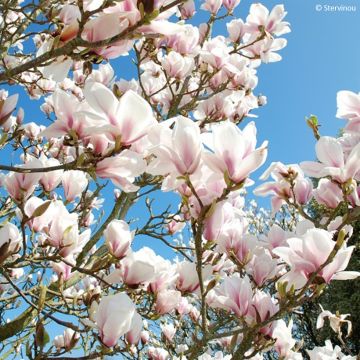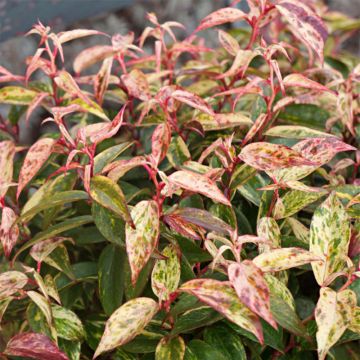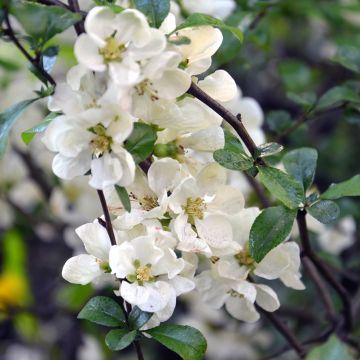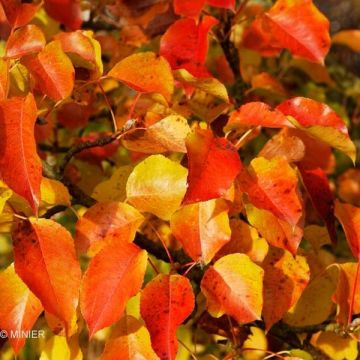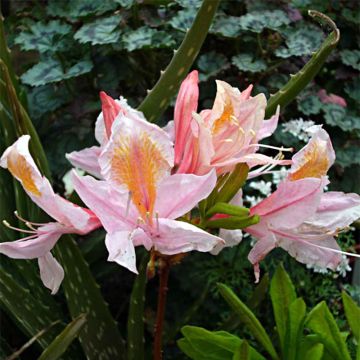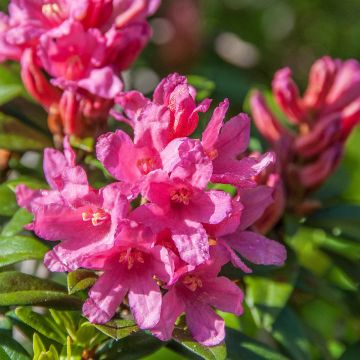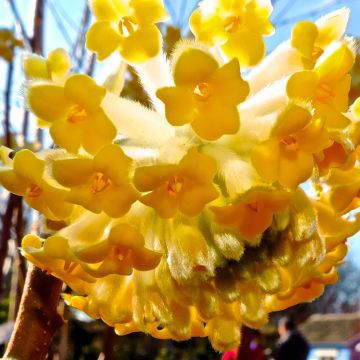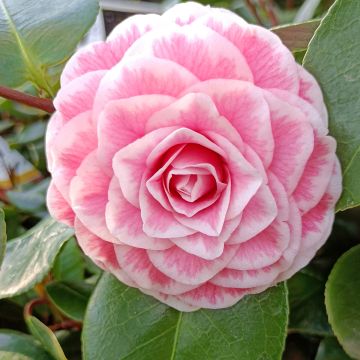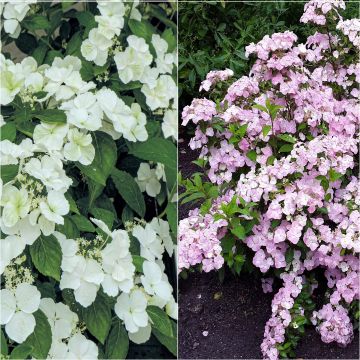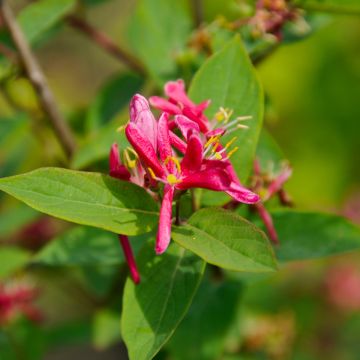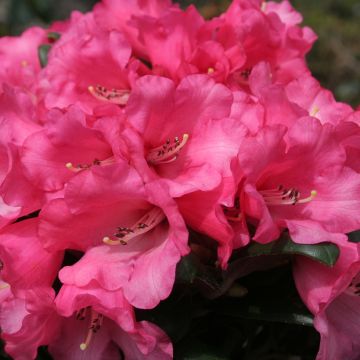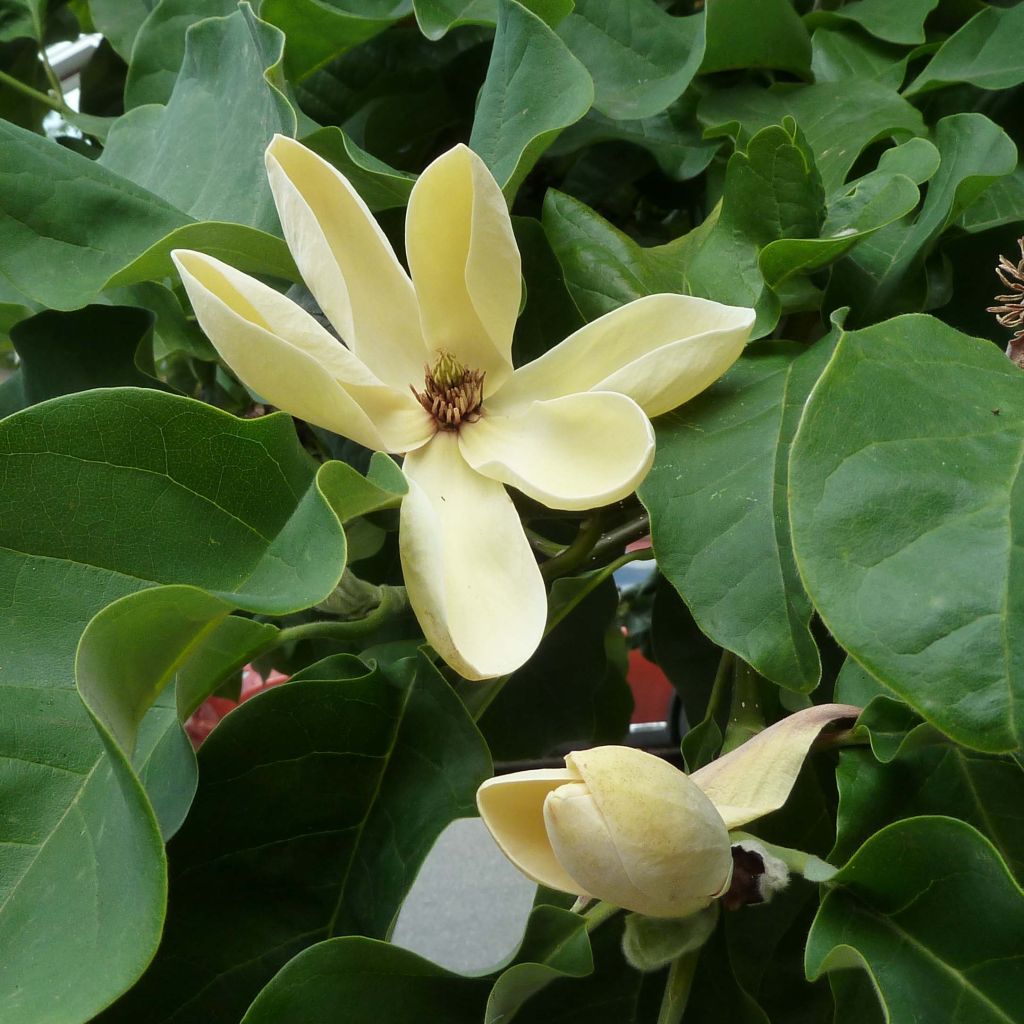

Magnolia x brooklynensis Yellow Bird
Magnolia x brooklynensis Yellow Bird
Magnolia x brooklynensis Yellow Bird
Magnolia
This item cannot be shipped to the selected country
Delivery charge from €5.90
Delivery to Corse prohibited
More information
Schedule delivery date,
and select date in basket
This plant carries a 24 months recovery warranty
More information
We guarantee the quality of our plants for a full growing cycle, and will replace at our expense any plant that fails to recover under normal climatic and planting conditions.
From €5.90 for pickup delivery and €6.90 for home delivery
Express home delivery from €8.90.
Delivery to Corse prohibited: UE law prohibits the import of this plant from mainland France to Corse as part of the fight against Xylella fastidiosa. Please accept our sincere apologies.
More information
Does this plant fit my garden?
Set up your Plantfit profile →
Description
Magnolia brooklynensis 'Yellow Bird' offers cup-shaped flowers in true narcissus-yellow, and is distinguished by excellent hardiness, a quality rarely observed in yellow-flowering varieties. It is part of an astonishing series of hybrids developed in the USA, at the Brooklyn Botanic Garden. Its cup-shaped flowers, whose curves resemble those of certain tulips, typically appear in early May, at the same time as the leaves, and sometimes again in summer depending on the growing conditions. With a beautiful stature, an elegant pyramidal habit, and an unusual flowering, it will become the star of the garden in spring. Give it a moist, preferably neutral or acidic soil, and a sunny or semi-shaded exposure.
Magnolia 'Yellow Bird', introduced in the USA in 1981, belongs to the Magnolia family, and is the result of hybridisation between Magnolia acuminata var. subcordata and M. x brooklynensis 'Eva Maria'. 'Yellow Bird' quickly forms a large bush or a small conical tree, taller than wide, reaching an average height of 8 m (26 ft) at maturity, with a width of 4 m (13 ft). Rapid during the first years, growth then slows down somewhat. Its deciduous foliage consists of large, fairly dark green, satin leaves, with a paler and finely villous underside. In early May, at the same time as the leaves develop, solitary and erect flowers of true yellow colour appear. These are cup-shaped, tall and wide, about 7 to 8 cm (2.8 to 3.1 in) in size. The buds preceding the flowers are protected by silky bracts. They release waxy and thick flowers with 6 tepals (undifferentiated sepals and petals) that are almost flat. They gradually open into an open cup around an exposed heart, revealing numerous stamens.
An outstanding spring tree, 'Yellow Bird' will work wonders in both a medium-sized garden and a large park. It is most often used as a solitary subject in the middle of a short grass meadow or in front of the house, where its remarkable flowering is always perceived as a miraculous event. It can be successfully combined with a field of interesting shrubs at other times of the year, such as a Japanese maple, an Anemone tree, a Prunus x subhirtella 'Autumnalis', or even a Cornus kousa 'Satomi'. It also pairs well with acid-loving plants (Rhododendrons, Camellias, Pieris, Hamamelis, etc.). Additionally, it is possible to create beautiful flowering hedges along paths, alternating this Magnolia with other cultivars, for example. Its root system is not dangerous to building foundations, so it can be installed against a house wall.
Report an error about the product description
Magnolia x brooklynensis Yellow Bird in pictures


Plant habit
Flowering
Foliage
Botanical data
Magnolia
x brooklynensis
Yellow Bird
Magnoliaceae
Magnolia
Cultivar or hybrid
Other Magnolia
Planting and care
Magnolia 'Yellow Bird' prefers sheltered situations, sunny to partially shady exposures, and a moist, well-drained, rich, neutral or acidic soil. It does not like overly dry soils, windy locations, or root competition, as its root system is shallow. It is very hardy (down to -25 °C (-13 °F)), but it is advisable to protect young specimens from frost for two or three years after planting. Note that late frosts and cold winds can damage flower buds and young leaves, thus affecting flowering. Magnolias can be planted in spring or autumn, outside the frost period. Prepare a hole 80 cm (31.5 in) wide and deep, with a good supply of heather soil and compost. Be careful when installing it in the hole, as the roots are fleshy but quite fragile. Immediate watering with non-calcareous water (rainwater) helps to compact the soil around the roots. During the first year of planting, magnolia requires watering once a week. It will appreciate compost once a year in spring. It is recommended to mulch around the base to retain moisture during the hot season, enrich the soil, and protect it from the cold in winter. As the roots are fragile, transplanting should be avoided. The only enemies of the magnolia are pests such as scale insects, snails, and slugs that attack young plants, and cryptogamic diseases (in overly waterlogged soil); coral disease can attack poorly pruned branches (careful pruning with well-maintained tools is necessary). It should be noted that magnolias are ornamental trees that tolerate air pollution well and that their roots are not a danger to building foundations.
Planting period
Intended location
Care
This item has not been reviewed yet - be the first to leave a review about it.
Spring-flowering shrubs
Haven't found what you were looking for?
Hardiness is the lowest winter temperature a plant can endure without suffering serious damage or even dying. However, hardiness is affected by location (a sheltered area, such as a patio), protection (winter cover) and soil type (hardiness is improved by well-drained soil).

Photo Sharing Terms & Conditions
In order to encourage gardeners to interact and share their experiences, Promesse de fleurs offers various media enabling content to be uploaded onto its Site - in particular via the ‘Photo sharing’ module.
The User agrees to refrain from:
- Posting any content that is illegal, prejudicial, insulting, racist, inciteful to hatred, revisionist, contrary to public decency, that infringes on privacy or on the privacy rights of third parties, in particular the publicity rights of persons and goods, intellectual property rights, or the right to privacy.
- Submitting content on behalf of a third party;
- Impersonate the identity of a third party and/or publish any personal information about a third party;
In general, the User undertakes to refrain from any unethical behaviour.
All Content (in particular text, comments, files, images, photos, videos, creative works, etc.), which may be subject to property or intellectual property rights, image or other private rights, shall remain the property of the User, subject to the limited rights granted by the terms of the licence granted by Promesse de fleurs as stated below. Users are at liberty to publish or not to publish such Content on the Site, notably via the ‘Photo Sharing’ facility, and accept that this Content shall be made public and freely accessible, notably on the Internet.
Users further acknowledge, undertake to have ,and guarantee that they hold all necessary rights and permissions to publish such material on the Site, in particular with regard to the legislation in force pertaining to any privacy, property, intellectual property, image, or contractual rights, or rights of any other nature. By publishing such Content on the Site, Users acknowledge accepting full liability as publishers of the Content within the meaning of the law, and grant Promesse de fleurs, free of charge, an inclusive, worldwide licence for the said Content for the entire duration of its publication, including all reproduction, representation, up/downloading, displaying, performing, transmission, and storage rights.
Users also grant permission for their name to be linked to the Content and accept that this link may not always be made available.
By engaging in posting material, Users consent to their Content becoming automatically accessible on the Internet, in particular on other sites and/or blogs and/or web pages of the Promesse de fleurs site, including in particular social pages and the Promesse de fleurs catalogue.
Users may secure the removal of entrusted content free of charge by issuing a simple request via our contact form.
The flowering period indicated on our website applies to countries and regions located in USDA zone 8 (France, the United Kingdom, Ireland, the Netherlands, etc.)
It will vary according to where you live:
- In zones 9 to 10 (Italy, Spain, Greece, etc.), flowering will occur about 2 to 4 weeks earlier.
- In zones 6 to 7 (Germany, Poland, Slovenia, and lower mountainous regions), flowering will be delayed by 2 to 3 weeks.
- In zone 5 (Central Europe, Scandinavia), blooming will be delayed by 3 to 5 weeks.
In temperate climates, pruning of spring-flowering shrubs (forsythia, spireas, etc.) should be done just after flowering.
Pruning of summer-flowering shrubs (Indian Lilac, Perovskia, etc.) can be done in winter or spring.
In cold regions as well as with frost-sensitive plants, avoid pruning too early when severe frosts may still occur.
The planting period indicated on our website applies to countries and regions located in USDA zone 8 (France, United Kingdom, Ireland, Netherlands).
It will vary according to where you live:
- In Mediterranean zones (Marseille, Madrid, Milan, etc.), autumn and winter are the best planting periods.
- In continental zones (Strasbourg, Munich, Vienna, etc.), delay planting by 2 to 3 weeks in spring and bring it forward by 2 to 4 weeks in autumn.
- In mountainous regions (the Alps, Pyrenees, Carpathians, etc.), it is best to plant in late spring (May-June) or late summer (August-September).
The harvesting period indicated on our website applies to countries and regions in USDA zone 8 (France, England, Ireland, the Netherlands).
In colder areas (Scandinavia, Poland, Austria...) fruit and vegetable harvests are likely to be delayed by 3-4 weeks.
In warmer areas (Italy, Spain, Greece, etc.), harvesting will probably take place earlier, depending on weather conditions.
The sowing periods indicated on our website apply to countries and regions within USDA Zone 8 (France, UK, Ireland, Netherlands).
In colder areas (Scandinavia, Poland, Austria...), delay any outdoor sowing by 3-4 weeks, or sow under glass.
In warmer climes (Italy, Spain, Greece, etc.), bring outdoor sowing forward by a few weeks.

































